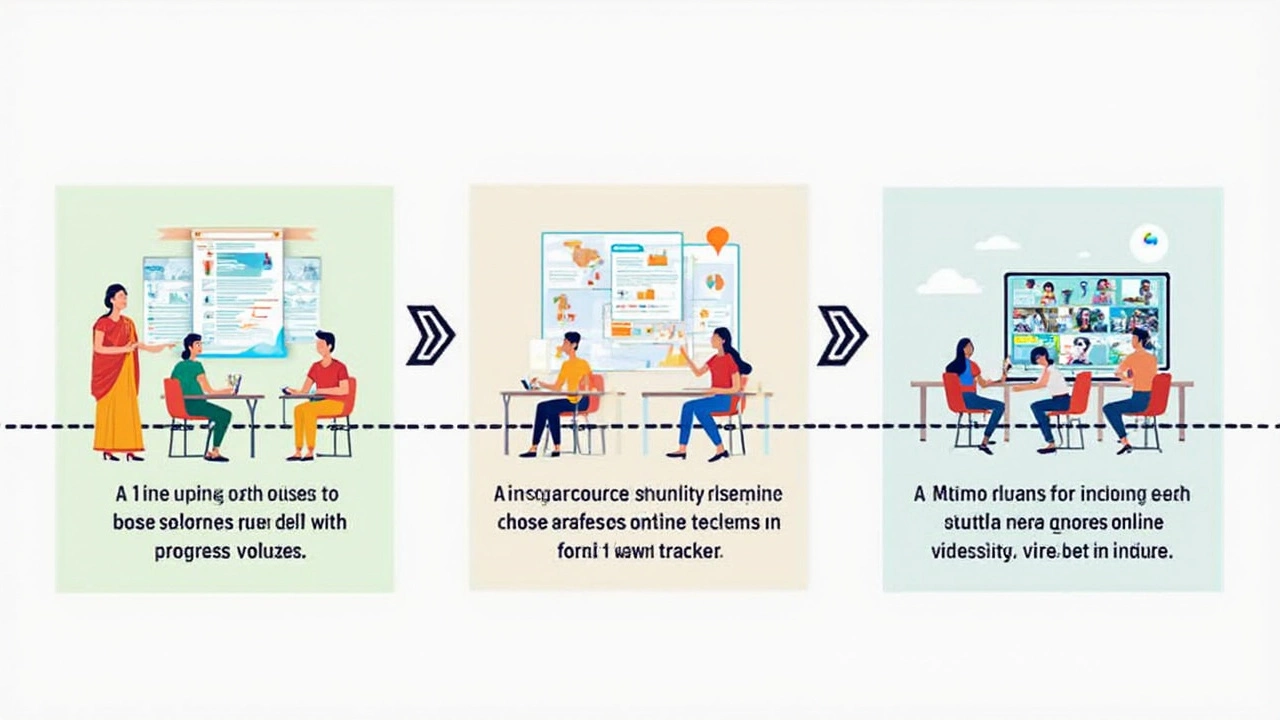Choosing an online learning platform feels a lot like picking a new phone—there are so many choices, and it’s easy to get lost in the details. If you break it down, though, it comes down to just three main types. Knowing the difference makes your life way easier.
The truth is, not every platform is made for every learner. Some are made for schools; some for anyone, anywhere; and others are like online shopping, but for courses. Ever wonder why Udemy and Coursera feel so different, or why your company’s training portal looks nothing like YouTube? It all boils down to their type.
If you know what each platform is really built for, you’ll waste less time and money. Start by figuring out whether you want to learn with a structured system, open online classes, or a pick-and-choose course marketplace. Each has its perks—and their own set of headaches.
- Learning Management Systems (LMS)
- Massive Open Online Courses (MOOCs)
- Course Marketplaces
- Key Features to Compare
- Finding the Right Fit for You
Learning Management Systems (LMS)
If you’ve ever taken an online class at school or gone through work training online, you’ve probably used a Learning Management System (LMS). These platforms keep everything in one place—lessons, quizzes, grades, and sometimes even class discussions.
The most popular names you’ll hear are Moodle, Blackboard, and Canvas. They’re the backbone for a lot of schools and big companies. In fact, over 70% of US higher education institutions use some form of LMS for delivering content and tracking student work.
What exactly does an LMS do? It’s like the control center for online education. Teachers use it to post lessons, track homework, and communicate with students. Learners log in to view assignments, submit work, join forums, and check out their progress.
- Centralized access: No need to chase down links or handouts—everything’s on the platform.
- Automated tracking: Grades and progress are tracked automatically, so you always know where you stand.
- Time-saving tools: Things like auto-graded quizzes and bulk messaging make teachers’ and admins’ lives easier.
Many e-learning platforms that run on LMS technology are also loaded with extra features, like video lectures, live chat, certificates, or mobile apps.
Here’s a quick look at a few LMS heavyweights:
| Platform | Main Use | Notable Feature |
|---|---|---|
| Moodle | Schools, Universities | Open-source, highly customizable |
| Canvas | Higher Education | Modern, mobile-friendly |
| Blackboard | Academic, Corporate | Strong reporting and analytics |
One thing to know—LMS platforms are designed for organized learning, not just casual browsing. If you want a step-by-step learning path, progress tracking, and feedback from instructors, this is your spot. They’re less about browsing random topics and more about following a set course, which is why schools and companies love them. If you’re looking into education technology or want a system you can trust for structure, an LMS is the way to go.
Massive Open Online Courses (MOOCs)
Ever wondered how millions of people can enroll in the same class, all around the world? Welcome to Massive Open Online Courses, or MOOCs. These are exactly what they sound like: online courses that are open to anyone, with no limits on student numbers. Platforms like Coursera, edX, Udacity, and FutureLearn are the big players here. You can find topics from coding in Python to philosophy—and often, the same course taught at famous universities like Harvard or MIT.
The main appeal of MOOCs is access. Anyone with an internet connection can join, whether you want a free ride or you’re paying for a certificate. If you’ve seen those “100 million learners” stats thrown around, it’s because Coursera itself had over 125 million registered users as of 2024.
Here’s what makes MOOCs stand out compared to other e-learning platforms:
- Open enrollment: No entrance exams or prerequisites for most courses. You just sign up and dive in.
- Self-paced (mostly): You can start anytime and go at your own speed, though some courses run on a set schedule.
- Courses from universities or top companies: Think Stanford, Google, Yale, and Amazon Web Services.
- Range of topics: Not just academic stuff—you'll find career skills, creative hobbies, and tech know-how.
- Certificates and even degrees: Many MOOCs offer paid certificates; some even go as far as full online degrees.
Want to compare platforms? Check out this quick table:
| Platform | Number of Courses (2024) | Price Range |
|---|---|---|
| Coursera | 7,000+ | Free to $49/month, degrees cost more |
| edX | 4,000+ | Free to $399+, degrees cost more |
| Udacity | 400+ | Mostly paid, average $399/month for Nanodegree |
| FutureLearn | 3,000+ | Free to $27/month for unlimited |
Tip: Don’t underestimate the discussion forums. MOOCs can feel lonely, but forums are where you’ll find help, tips, and often, study groups. If you’re after a flexible way to learn from top teachers for free or nearly free, MOOCs are your friend. Just keep in mind, only about 10% of people actually finish them—stay motivated and you’ll be way ahead of the curve.

Course Marketplaces
When people think of e-learning platforms, big names like Udemy, Skillshare, and Coursera’s open catalogue usually come to mind. These are called course marketplaces. They’re a bit like online stores, but instead of gadgets or clothes, you browse thousands of courses on nearly every topic you can imagine.
Anyone (well, almost anyone) can create and upload a course. The platform does the heavy lifting — it handles payments, hosts the videos, and gives you tools to promote what you make. For students, it’s a goldmine for picking up skills at your own pace with reviews and ratings right in front of you. Want a deep dive into Python? Or a crash course on photography? You’ll find both, side by side.
One thing people love about these marketplaces is choice. In 2024, Udemy alone had more than 210,000 active courses and over 60 million students. That’s a bigger selection than most traditional universities could ever dream of.
Here’s what sets course marketplaces apart from other online platforms:
- You pay per course, not per semester or membership (though Skillshare works on a subscription model).
- The course creators come from all walks of life—professors, industry pros, or even talented hobbyists.
- You can see student reviews and star ratings before you buy into anything.
- Most allow lifetime access to purchased content, so you learn at your speed.
- No need to wait for semester start dates—courses run year-round.
Thinking of making your own course? Course marketplaces take a cut, but they get your course in front of a global audience. And if you’re shopping for skills, remember to check the ratings, preview the intro lessons, and see if the instructor actually interacts with students.
If you want a quick glance at how a couple of these platforms compare, here’s a handy table:
| Platform | Pricing Model | No. of Courses | Key Feature |
|---|---|---|---|
| Udemy | Pay per course | 210,000+ | Lifetime access |
| Skillshare | Subscription | 35,000+ | Project-based learning |
These learning management systems aren’t just for techies or students, either. If you’re switching careers, trying something new, or just filling in the gaps from school, course marketplaces let you set the pace and pick exactly what you need.
Key Features to Compare
When it comes to picking an e-learning platform, it’s easy to get distracted by fancy videos or slick websites. But what really makes a difference? You want to look at features that actually improve your learning. Here’s what matters most.
- Course Variety: Some platforms (like most course marketplaces) let anyone create a course, so there’s a huge range of topics, from Excel skills to guitar basics. Others—especially Learning Management Systems (LMS) and MOOCs—are more focused on academic or professional subjects.
- Certification and Credentials: Do you get a piece of paper at the end? Coursera and edX offer certificates you can add to your LinkedIn, while some platforms only give you completion badges. If you want your courses to help you get a job or promotion, this is huge.
- Ease of Use: Nobody wants to spend an hour just figuring out where a lesson is. A clean dashboard and clear navigation save a ton of headaches. Some education technology sites even have mobile apps that make learning possible on the bus or in bed.
- Interactive Tools: Quizzes, discussion boards, coding sandboxes, and live webinars all help you actually learn—not just memorize. Think about Duolingo (lots of quizzes) vs. a platform that’s just text and videos.
- Content Updates: Are courses regularly updated, or do you risk learning outdated info? Platforms like Udemy let instructors update their content whenever they want. On the other hand, some traditional LMS setups go years without a refresh.
- Support and Community: If you hit a wall, good support matters. Forums, active instructor responses, and even live chat can keep you moving. Some platforms have bustling peer support groups, while others are just tumbleweeds.
- Price Structure: Some online platforms offer pay-per-course, others use a subscription, and some are free (but may upsell you on extra features). A lot of people don’t realize that many MOOCs let you audit classes for free if you skip the certificate.
| Feature | LMS | MOOC | Marketplace |
|---|---|---|---|
| Certification | Internal or None | Official/University-backed | Yes, but varies |
| Course Variety | Limited, usually job-focused | Broad academic subjects | Huge, all sorts of topics |
| User Community | Small, private | Large, global | Open, varied |
| Pricing | Paid by company/school | Free or paid certificate | Varies—some cheap, some pricey |
One tip: always try the free version (or free trial) before putting down your credit card. You’ll quickly see if the layout, teaching style, and community fit your vibe. And don’t forget to check refund policies—some platforms are stricter than a school principal.

Finding the Right Fit for You
Nailing down the right e-learning platforms can save you frustration later. The first step? Get clear about your goal. Are you after a job-ready skill, tackling a university requirement, or just learning something fun on the side?
If you want guidance and structure, a Learning Management System (LMS) is your jam. Schools and companies use these all the time for tracking progress, grades, and making sure you finish courses. Think platforms like Blackboard or Moodle. They’re built for accountability—if you need reminders and checklists, that’s where they shine.
If you’re curious about popular topics from top universities or experts and want more flexibility, Massive Open Online Courses (MOOCs) like Coursera, edX, or FutureLearn are hard to beat. The stats say over 220 million learners signed up for MOOCs globally in 2024. Some courses are even free if you don’t need a certificate, which is a solid plus if you’re on a budget.
Want ultimate freedom and a wide mix of choices? Course Marketplaces like Udemy or Skillshare have you covered. Here, anyone can create or take a class on anything from coding to dog training. You can start at any time—great for self-starters or folks who hate strict schedules.
- Ask yourself how much support you want. Do you like live classes, chats, and feedback, or would you rather just hit play and pause when you feel like?
- Check for reviews and completion rates—more people finish courses on platforms that match their learning style. For example, the average completion rate for MOOCs is under 10%, but those who choose guided, cohort-style courses (like those found in some LMS-based setups) finish at much higher rates.
- Budget matters, too. Some online platforms charge by the month, others by the course, and a few offer subscription access to all their content. Double check for hidden fees before you commit.
- Look at the extra features. Mobile access, downloadable resources, and real-world projects can make or break your learning experience.
| Platform Type | Best For | Average Cost |
|---|---|---|
| LMS | Formal study, corporate training | Usually paid by institution |
| MOOCs | University-level courses, popular skills | Free (audit); $30-200 for certificates |
| Marketplaces | Personal development, hobbies | $10-$50/course or monthly fee |
Bottom line: try a platform’s free trial if they offer it. That’s the easiest way to figure out what fits your pace and learning vibes. The perfect education technology feels natural, not forced.
